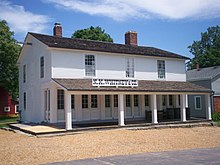Algernon Sidney Gilbert | |
|---|---|
| Born | December 28, 1789 |
| Died | June 29, 1834 |
| Occupation | Merchant |
| Known for | Partnering with Newel K. Whitney at the N. K. Whitney & Co. store in Kirtland, Ohio |
| Spouse | Elizabeth Van Benthusen |
| Children | 1 |
Algernon Sidney Gilbert (December 28, 1789 – June 29, 1834) was a merchant best known for his involvement with Latter-day Saint history and his partnership with Newel K. Whitney in Kirtland, Ohio. He is mentioned in seven sections of The Church of Jesus Christ of Latter-day Saints Doctrine and Covenants.[1] He was ordained as a high priest in the state of Missouri and served as a missionary in the United States.[2]
Personal life[edit]

Gilbert was born on December 28, 1789, at New Haven, Connecticut, to Eli Gilbert and Lydia Hemingway.[3] He married Elizabeth Van Benthusen, September 30, 1823, in Chagrin (later Willoughby), Ohio.[2] The two had one son.[3]
Gilbert moved to Mentor, Ohio, which was very close to Kirtland, around 1819, and took out a large loan, which he struggled to pay off until 1826. [4]: 78–87 He moved to Kirtland in 1826 and was a partner with Newel K. Whitney in the N. K. Whitney & Co. store by 1827. In 1831 he moved to Independence, Missouri, opened a store there, and was appointed bishop's agent.[2]
Latter-day Saint[edit]
Gilbert was baptized into the Church of Christ in the spring of 1831 and church founder Joseph Smith ordained him an elder on June 6, 1831. He was ordained a high priest by Smith on April 26, 1832, in Kirtland and appointed one of seven high priests in the presiding high council in Missouri. He served as a missionary in the eastern United States from June to December 1832.[2]
Gilbert was appointed to start a store in Missouri in 1831, where Whitney and Company purchased land at a central intersection. Whitney probably sent money to help support the store.[4]: 103–105 Open conflict with earlier settlers in Jackson County, Missouri, ensued after members began moving there, driven by religious and cultural differences, and the perception by pro-slavery Missourians that the "Yankee" "Mormons" were abolitionists.[5] Vigilantes in the public and private sector used force to drive individual Latter-day Saints from Jackson to nearby counties within Missouri; eventually, Latter-day Saints were given until the end of November 6, 1833, to leave the county en masse.[6] Gilbert condemned church leaders in a letter in 1832; the church leaders promised Gilbert that God would bless him with prosperity if he was faithful. A mob came to Independence, Missouri, in July 1833 and destroyed many things. Gilbert sold what he could before leaving Missouri.[4]: 103–105
On November 4, 1833, Gilbert was arrested and imprisoned for seven days at Independence and was among the Latter-day Saints driven from Jackson into Clay County, Missouri, later that month.[2] He died of cholera in Clay County on June 29, 1834.[3]
See also[edit]
- 1838 Mormon War: Background
- History of the Latter Day Saint Movement in Missouri
- Zion (Latter Day Saints)
Sources[edit]
- ^ See Sections 53, 57, 61, 64, 82, 90, and 101.
- ^ a b c d e Biography Archived 2012-01-05 at the Wayback Machine of Algernon Sidney Gilbert, The Joseph Smith Papers (accessed January 6, 2012)
- ^ a b c McCune, George M. (1991). Personalities in the Doctrine and Covenants and Joseph Smith–History. Salt Lake City, Utah: Hawkes Publishing. p. 44. ISBN 9780890365182.
- ^ a b c Staker, Mark (2003). "Thou Art the Man: Newel K. Whitney in Ohio". BYU Studies. 42 (1): 74–138. Retrieved 11 October 2017.
- ^ "The Manifesto of the Mob" (From History of the Church, Volume 1, pages 374-376) Black Members of The Church of Jesus Christ of Latter-day Saints. BlackLDS.com. Retrieved January 6, 2012.
- ^ Saints:LDS History Ch 17